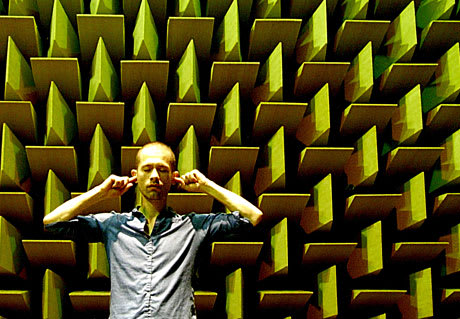It's like the riddle of one hand clapping: what does the ear itself sound like? Danish sound artist Jacob Kirkegaard, obviously not satisfied with mere Zen rhetoric, set forth to find out. The recording of Labyrinthitis was done in a soundproof booth in a medical facility for the treatment of hearing disorders. With a system of tiny speakers and microphones affixed, two competing tones were sent into Kirkegaard's ear and a third tone created within its tiny cave was recorded as it emerged. As the recording progressed, a cascade of tones meant to interact with each new emission created a slowly shifting array of ear tones. Listening to the 40-minute piece as it appears on CD replicates this slightly disconcerting space of resonance from both within and outside the ears, making the sound eerily source-less and encompassing. Other factors, like the use of headphones or the shape and resonance of a chosen room, surely would have some bearing, but multiple listens produced fairly consistent results. Live, Kirkegaard turns his internal experience outward, essentially communicating to the audience his act of hearing. It's affecting both physically and conceptually to share so instantaneously in an artwork's creation.
How big a fan of Alvin Lucier are you?
I love his works. His piece "I Am Sitting In A Room" was an important inspiration for me to create my Chernobyl work, AION and 4 ROOMS.
Has anyone reported any disorienting experiences with the album?
No, actually not. Even elderly people have responded positively. I remember a man who was 70-percent deaf telling me that he hadn't had such a clear hearing experience for years.
Couldn't the sounds on Labyrinthitis be created in a less esoteric manner, electronically or otherwise?
It is also possible to generate the sounds inside the ears of the listener using only sine waves. [That] would give a more precise ratio between the tones and thereby cause more precise tones inside the ears. But since I am not a scientist and [am] rather interested in the conceptual paradox of my ear tones evoking ear tones in the ears of the listener, I naturally chose to use the recordings from my own ear. I always prefer to work with real sounds instead of synthetic sounds because real sounds have a fragility and their own unstable lives. [That] makes the work much more interesting and alive to listen to.
(Touch)How big a fan of Alvin Lucier are you?
I love his works. His piece "I Am Sitting In A Room" was an important inspiration for me to create my Chernobyl work, AION and 4 ROOMS.
Has anyone reported any disorienting experiences with the album?
No, actually not. Even elderly people have responded positively. I remember a man who was 70-percent deaf telling me that he hadn't had such a clear hearing experience for years.
Couldn't the sounds on Labyrinthitis be created in a less esoteric manner, electronically or otherwise?
It is also possible to generate the sounds inside the ears of the listener using only sine waves. [That] would give a more precise ratio between the tones and thereby cause more precise tones inside the ears. But since I am not a scientist and [am] rather interested in the conceptual paradox of my ear tones evoking ear tones in the ears of the listener, I naturally chose to use the recordings from my own ear. I always prefer to work with real sounds instead of synthetic sounds because real sounds have a fragility and their own unstable lives. [That] makes the work much more interesting and alive to listen to.
